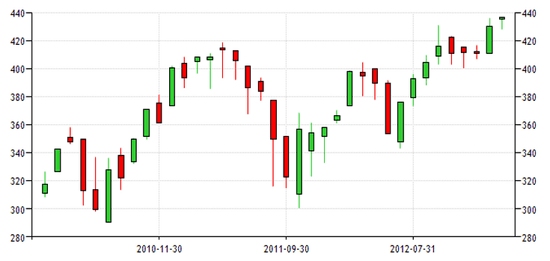Oslo Børs in History Oslo Børs had its humble beginnings as Christiania Børs. Christiania, the capital of Norway then, was largely composed of a community of fishermen and farmers with mere 10,000 inhabitants. The economic landscape of Norway in 1800’s was weak due to the lack of commercial activity. To stimulate greater commercial activities, it was decided that there has to be a commercial exchange that would encourage such end. Thus, in 1818, Nicolay Andresen, also known as the father of the Oslo Stock Exchange, along with committee of four businessmen made the proposal for a commercial exchange to the Parliament; and they later on, were responsible in advancing the progress of the exchange. The Norwegian Stock Exchange first started out as a business in currency trading and trading of bills of exchange. The exchange of commodities and the listing of several financial instruments did not start until the later years of the century. Railway shares accounted for a major part of the listed shares in 1881 and the exchange of commodities was partly brought about by the listing of prices for a wide range of goods during the years that leads up to the First World War. Norwegian Stock Exchange Booms and Busts The years following the First World War have seen a boom in the Norwegian Stock Exchange. This is largely due to companies that had sprung up during these years and many people wanted to take part of the trading action, buying shares that pushed the prices up. And then, in 1969, Norway’s foray into the oil industry was set in motion following the discovery of commercially exploitable oil reserves in Ekofisk, Norway. Furthermore, Norwegian economy enjoyed another boost due to political decisions and succeeding regulations that encouraged savers and investors to buy securities. Another period wherein the Norwegian stock exchange experienced a marked boom is during 1999 and early months of 2000. This was largely due to the dotcom phenomena where even companies with tenuous link to technology experienced a sharp surge in prices. A stock market cycle is never complete without busts, and the Oslo Børs had its fair share of those too. For example, the years between the First World and Second World War have seen crisis on the Norwegian economy. In addition, the Wall Street crash of 1929 is not without its effect on Oslo Børs as well. Also, in the year 1987, the world saw New York share prices fell sharply, which set the stage for Norway’s sharpest fall in share prices in a single trading day – 19% fall in share index. Norway Stock Market in Recent Years In recent months, the Oslo Børs had a positive performance with a 3% or 30 points rally during the last 30 days. Historically, between the years 1996-2013, a major Norway Stock Market index (OBX), in April 2006, reached the all-time high of 1382 points and the all-time record low of 77 points in January 2006. This is based on the performance of 25 most traded stocks of Oslo Børs.  Should You Invest in the Oslo Børs? Investors who are looking for investment opportunities in foreign markets may see the allure of investing in Norway with its excellent fiscal sheets and its high GDP per capita (Norway has the second highest GDP per capita and the fourth highest GDP at purchasing power parity per capita). And of course, there’s the fact that the country sits upon large oil reserves making it a safe haven in terms of economic stability even in the midst of global and European economic downturn. If we have to look at it ETF-wise, Global X Norway ETF (NORW) is the main US based security, which trades Norwegian stocks. However, NORW doesn’t have options listed and doesn’t trade with much volume. While there have been encouraging signs in the Euro situation recently, the crisis is far from over. However, investors may think that a pot at the end of the rainbow may be what’s in store for them for withstanding Europe’s volatility. Thus, if you want to play European stocks but don’t want to risk the chance that another crisis might be brewing in the future, Norway offers one of the safest economies where you could invest your money. While Norway’s economy may be sensitive to any downturns in Europe because two thirds of its export still go to European region and it is still a part of the European Economic Area (although it stayed out of the European Union), the country’s banks has the least exposure to Euro countries that is most vulnerable to crisis. Additionally, its economy depends largely on its natural resources like minerals, oil reserves, and hydropower. Thus, Norway is poised to benefit largely from rising oil prices, making it a safe haven for investors wishing to stake their money in Europe’s optimistic outlook. comments powered by Disqus |

|
|
|
|







